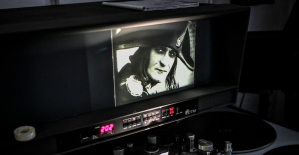The leading actor was a drunkard and loved to fill journalists up so much at lunchtime that they could hardly babble. The director was considered free of any kind of humor. And where exactly the story was to develop was not clear to anyone for a long time - in short: the shooting of this film was a perfect scenario for a disaster. But to this day people talk about this strip, which premiered on November 26, 1942.
Of course, nowadays there are people who don't mean anything by the names "Casablanca", Humphrey Bogart and Ingrid Bergman. But that's their problem. The rest of the world either gets a wet gleam in their eyes, or at least a hint of a smile spreads across their faces. Because what the ladies and gentlemen around the bar owner Rick Blaine pull off on the screen is still an unsurpassed mixture of drama, morality and wit.
In the middle of the inferno of the Second World War, building up a story about visas that would mean the way to freedom for those persecuted by the Nazi regime from the Moroccan city and combining this with a love triangle story was quite simply a stroke of genius by the Warner production company. The production also ensured that Humphrey Bogart in particular was remembered even in the 21st century.
The cult of the man in the trench coat and with the cigarette in the corner of his mouth has certainly waned in the turbulent times. A masculinity that hides its pragmatic moral code behind sarcasm and hard drinks just doesn't fit with the total hyper-empathy that men have come to display for certain audiences. But Bogie hasn't disappeared yet; he has contributed too much to what not only nostalgics call "Hollywood's golden years".
Personally, his long post-fame would certainly have amusement him, at least on the outside. "Nothing is more boring than yesterday's newspaper and a dead actor," the man said shortly before his death in January 1957. The countless drinking bouts and fags had not only given him his character face, but at some point also oesophageal cancer. But that was still a long way off in 1942 - and the role of bar owner Rick Blaine in "Casablanca" was a jackpot for Bogart because it included everything he was particularly good at.
Born in New York in 1899 as a boy from a good family, he quickly attracted attention in various private schools for his lousy behavior. His career in the Navy was short, so he switched to a field that makes very few famous, but leaves most people with a bad existence: Humphrey Bogart tried his hand at acting in the 1920s. You couldn't deny him a certain toughness. Even when some Broadway comedies with his participation failed miserably, he kept going.
He made it into film in the 1930s, but it wasn't a real breakthrough. Gangster strips were very popular, Warner had its own "Murder's Row" consisting of James Cagney, George Raft - and most recently Bogart. The productions were mass-produced: "I always said the same sentences, things like: 'Hands up, everyone against the wall.' Then I was shot first and never got the girl," said the actor later in an interview, whose partner he is obviously hadn't drunk all the way to the wall.
The development to stardom only began in 1941 with John Huston's "The Trail of the Falcon". As private investigator Sam Spade, Bogart has no problem dragging his business partner's wife to bed and making fun of her after his violent death. But in the mythical hunt for an allegedly valuable figure of the bird, he develops enough integrity, in spite of all the toughness, not to end up as a villain. Bogart is said to have received angry letters of protest from American prisons - the inmates hated the thought that he had now gone over to the good guys.
And then Casablanca. For the first half hour, Rick Blaine acts like someone you don't want anything to do with in his bar. Somehow severely disappointed in life, he hides behind his liquor bottle in his white jacket: and whenever it comes to confronting the forces of darkness, he pretends he's not there.
Now the situation is actually not particularly refreshing for him: instead of eloping with him in Paris before the German occupation, as agreed, the beautiful Ilsa Lund (Ingrid Bergman) leaves him standing in the rain at the train station because she goes to her resistance fighter Victor László (Paul Henreid) goes back. And now the two of them appear in "Rick's Café Americain" of all places to get visas for a plane to Lisbon.
It doesn't make things any better that a few Germans, led by the mean Major Strasser, are putting pressure on Rick. But maybe it's exactly what allows the bar owner to find himself. First he lets his band drown out the "Wacht am Rhein" from the "Marseillaise", then he actually renounces the beautiful Ilsa with nobility, although she credibly promised him that she would not be able to leave him again. And in between the pianist Sam (Dooley Wilson) plays "As time goes by" again and again.
But it's not just this plot that makes the film so strong. Ingrid Bergman's mysterious look had to do with the fact that for a long time nobody knew how the story would end. There were also supporting characters like the corrupt French prefect Louis, who hints at the end that things are about to change. And then there are the dialogues: "What is your nationality?" Major Strasser, a German, wants to know from Rick. He replies: "I'm a drinker." Postscript from the French prefect: "And that makes Rick a citizen of the world."
Another irony of "Casablanca" is less beautiful. Most of the actors in this film were escapees themselves: Conrad Veidt, who played Major Strasser - in reality an anti-fascist and émigré. Szöke Szakáll, who plays the hearty, fat head waiter – a Hungarian Jew from the Danube Monarchy who managed to flee to America at the last minute; three sisters were murdered in concentration camps. And of course Manó Kaminer Kertész, the director, who called himself Michael Curtiz in Hollywood. Although he had already emigrated to America in 1926, he also lost family members in Auschwitz.
The film grossed $3.6 million, but it made the really big bucks over the long haul. In Germany, the film was only shown to the public in the 1950s - and in a shortened version that did not contain any evil Germans. The original only seemed reasonable to German citizens in 1975, when Bogart spoke the words "I see you in the eyes, little one" (originally "Here's looking at you, kid") for the first time in the dubbing. Especially in the USA, the cult has lasted since the 1950s. Elite universities always show the strip at Christmas time, so cultural heritage is created.
The film won the Oscar, while Humphrey Bogart didn't. He was to repeat this feat in 1952 alongside Katharine Hepburn in "African Queen". After his marriage to Lauren Bacall, when he wasn't on the set, he increasingly locked himself away in the posh restaurant "Romanoff's" or spent a lot of time on his yacht "Santana". No one could ever duplicate his looks, his terse body language and his dry remarks. You probably become a legend that really deserves its name.
You can also find "World History" on Facebook. We are happy about a like.

 Iran-Israel conflict: what we know about the events of the night after the explosions in Isfahan
Iran-Israel conflict: what we know about the events of the night after the explosions in Isfahan Sydney: Assyrian bishop stabbed, conservative TikToker outspoken on Islam
Sydney: Assyrian bishop stabbed, conservative TikToker outspoken on Islam Torrential rains in Dubai: “The event is so intense that we cannot find analogues in our databases”
Torrential rains in Dubai: “The event is so intense that we cannot find analogues in our databases” Rishi Sunak wants a tobacco-free UK
Rishi Sunak wants a tobacco-free UK Alert on the return of whooping cough, a dangerous respiratory infection for babies
Alert on the return of whooping cough, a dangerous respiratory infection for babies Can relaxation, sophrology and meditation help with insomnia?
Can relaxation, sophrology and meditation help with insomnia? WHO concerned about spread of H5N1 avian flu to new species, including humans
WHO concerned about spread of H5N1 avian flu to new species, including humans New generation mosquito nets prove much more effective against malaria
New generation mosquito nets prove much more effective against malaria The A13 motorway closed in both directions for an “indefinite period” between Paris and Normandy
The A13 motorway closed in both directions for an “indefinite period” between Paris and Normandy The commitment to reduce taxes of 2 billion euros for households “will be kept”, assures Gabriel Attal
The commitment to reduce taxes of 2 billion euros for households “will be kept”, assures Gabriel Attal Unemployment insurance: Gabriel Attal leans more towards a tightening of affiliation conditions
Unemployment insurance: Gabriel Attal leans more towards a tightening of affiliation conditions “Shrinkflation”: soon posters on shelves to alert consumers
“Shrinkflation”: soon posters on shelves to alert consumers The restored first part of Abel Gance's Napoléon presented at Cannes Classics
The restored first part of Abel Gance's Napoléon presented at Cannes Classics Sting and Deep Purple once again on the bill at the next Montreux Jazz Festival
Sting and Deep Purple once again on the bill at the next Montreux Jazz Festival Rachida Dati: one hundred days of Culture on the credo of anti-elitism
Rachida Dati: one hundred days of Culture on the credo of anti-elitism The unbearable wait for Marlène Schiappa’s next masterpiece
The unbearable wait for Marlène Schiappa’s next masterpiece Skoda Kodiaq 2024: a 'beast' plug-in hybrid SUV
Skoda Kodiaq 2024: a 'beast' plug-in hybrid SUV Tesla launches a new Model Y with 600 km of autonomy at a "more accessible price"
Tesla launches a new Model Y with 600 km of autonomy at a "more accessible price" The 10 best-selling cars in March 2024 in Spain: sales fall due to Easter
The 10 best-selling cars in March 2024 in Spain: sales fall due to Easter A private jet company buys more than 100 flying cars
A private jet company buys more than 100 flying cars This is how housing prices have changed in Spain in the last decade
This is how housing prices have changed in Spain in the last decade The home mortgage firm drops 10% in January and interest soars to 3.46%
The home mortgage firm drops 10% in January and interest soars to 3.46% The jewel of the Rocío de Nagüeles urbanization: a dream villa in Marbella
The jewel of the Rocío de Nagüeles urbanization: a dream villa in Marbella Rental prices grow by 7.3% in February: where does it go up and where does it go down?
Rental prices grow by 7.3% in February: where does it go up and where does it go down? With the promise of a “real burst of authority”, Gabriel Attal provokes the ire of the opposition
With the promise of a “real burst of authority”, Gabriel Attal provokes the ire of the opposition Europeans: the schedule of debates to follow between now and June 9
Europeans: the schedule of debates to follow between now and June 9 Europeans: “In France, there is a left and there is a right,” assures Bellamy
Europeans: “In France, there is a left and there is a right,” assures Bellamy During the night of the economy, the right points out the budgetary flaws of the macronie
During the night of the economy, the right points out the budgetary flaws of the macronie These French cities that will boycott the World Cup in Qatar
These French cities that will boycott the World Cup in Qatar Champions League: France out of the race for 5th qualifying place
Champions League: France out of the race for 5th qualifying place Ligue 1: at what time and on which channel to watch Nantes-Rennes?
Ligue 1: at what time and on which channel to watch Nantes-Rennes? Marseille-Benfica: 2.99 million viewers watching OM’s victory on M6
Marseille-Benfica: 2.99 million viewers watching OM’s victory on M6 Cycling: Cofidis continues its professional adventure until 2028
Cycling: Cofidis continues its professional adventure until 2028


















